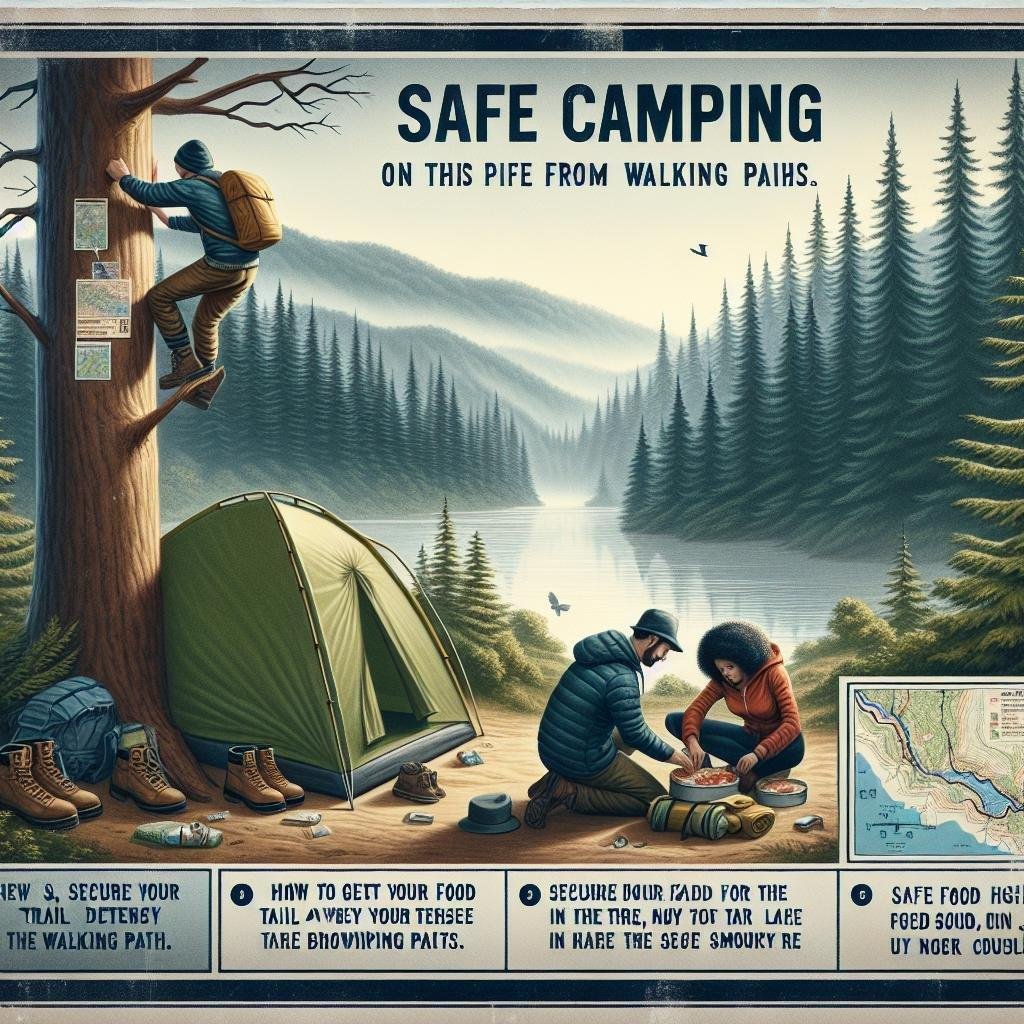Teh majestic expanse of the Smoky Mountains beckons adventurers with its lush landscapes, whispering streams, and timeworn trails that wind through ancient forests. As you lace up your boots and prepare to chart a course into this verdant labyrinth, the promise of untamed beauty is only rivaled by the call of nights spent under a canopy of stars. Though, camping along these storied paths requires more than just an adventurous spirit; it demands planning, respect for nature, and an understanding of the region’s delicate ecosystem. In this article, we will explore the essential steps to ensure that your camping excursion is not only memorable and exhilarating but also safe and environmentally conscious. Whether you’re a seasoned trekker or a spirited newcomer, these guidelines will equip you with the knowledge to protect yourself and preserve the splendor of the Smokies for generations to come.
Choosing the Perfect Campsite: Balancing Beauty and Safety
When planning an excursion in the Smoky Mountains,the right campsite can make all the difference between a delightful night under the stars and a less-than-ideal experience.Prioritize both natural splendor and security in your site selection by considering these elements: proximity to natural water sources, level terrain, and adequate shelter options. Fairy-tale views are captivating,but be mindful of potential hazards such as falling branches or unstable ground. Use this checklist to ensure a balanced choice:
- Avoid setting up camp on a hilltop to prevent exposure to strong winds.
- Look for sites with natural windbreaks like shrubs or boulders.
- Ensure there is sufficient canopy coverage for shade and weather protection.
- Maintain a respectful distance from wildlife trails and nesting sites.
In addition, safety should never be compromised for aesthetics, so be prepared to relocate if the site doesn’t meet essential criteria. To assist in quick evaluations, consider the following table on practical safety vs. visual charms:
| Safety Priorities | Scenic Elements |
|---|---|
| accessibility to main trail | Panoramic views |
| Surrounding vegetation | Proximity to water features |
| Stable ground conditions | Wildflower presence |

Essential Gear for a Secure and Comfortable Adventure
- tent: A durable, weather-resistant tent is crucial for camping in the Smoky Mountains. Opt for a tent that can withstand sudden weather changes, providing a secure sanctuary during your escapades. Consider one with a lightweight design yet sturdy enough to handle the rugged terrain.
- Backpack: A high-quality backpack is more than just a storage bag. Choose one with ample room and multiple compartments to organise gear like clothes, food, maps, and a first-aid kit. Look for features such as padded shoulder straps and breathable back panels for enhanced comfort during long hikes.
- Sleeping System: For a restful night under the stars, invest in a robust sleeping system, including a compact sleeping bag and sleeping pad suited to the mountain climate. Select materials that retain warmth while allowing breathability, crucial for varying temperatures.
| Item | Recommended Features |
|---|---|
| Cooking Gear | lightweight, portable, quick fuel ignition |
| Navigation Tools | GPS device, topographical maps |
| Lighting | Headlamp, long battery life, waterproof |
Additionally, every adventurer should pack a first-aid kit tailored to address unexpected injuries or ailments that may arise in remote mountainscapes. This handy kit should contain essentials like antiseptic wipes, gauze, band-aids, and medications for allergies or pain relief. Clothing should be layered to adapt to the ever-changing mountain climate, offering comfort and protection against both wind chill and sun exposure. Don’t forget to bring environmentally pleasant products to minimize your impact on the pristine wilderness.

wildlife Awareness: Coexisting safe in the Great outdoors
To ensure a safe and respectful adventure while camping in the Smoky Mountains,it’s vital to remain mindful of the ecosystem and the creatures that call it home. First, familiarize yourself with the local wildlife you may encounter, such as black bears, bobcats, and elk. understanding their natural behaviour can significantly enhance your camping experience and safety. As an example, proper food storage is crucial: always store food in bear-proof containers and hang them at least 10 feet above the ground when possible. Additionally,setting camp at least 200 feet from any trails or water sources can minimize disturbances to the wildlife.
- Pack out all trash: Keep the trails clean and prevent attracting animals.
- Make noise while hiking to avoid startling wildlife.
- Travel in groups, as animals are less likely to approach larger groups.
Managing your campsite goes beyond respecting animal neighbors — it’s about protecting and enjoying the natural environment responsibly. Training yourself and fellow campers to adhere to Leave No Trace principles can vastly improve the wilderness experience for everyone. Keep your campsite compact, and avoid expanding your impact by strictly following existing paths and designated camping spots. Check weather reports prior to your trip to anticipate any conditions that could impact both your safety and that of the local wildlife. Below, find a small reference table for wildlife encounter tips:
| Animal | Action |
|---|---|
| bear | Back away slowly, do not run. |
| Snake | Stay still, than calmly step back. |
| Elk | Respect their space, never approach. |

Weathering the Elements: Preparing for Smoky Mountain Conditions
Camping in the Smoky Mountains is an adventure best undertaken with well-prepared plans to handle the diverse weather patterns and potential environmental challenges. To ensure your camping experience is both enjoyable and safe, start by packing essential gear that includes waterproof clothing, sturdy footwear, and breathable layers. The weather in the Smokies can be unpredictable, often shifting from luminous sunshine to sudden downpours. A well-stocked first aid kit is crucial for dealing with any unforeseen exigencies. Additionally, it’s wise to carry a detailed trail map, a reliable compass, and a fully charged portable phone charger to navigate and keep connected in the vast wilderness.
In addition to personal gear, keeping an eye on weather forecasts is invaluable. Being aware of potential storms or rapid temperature drops can guide your daily plans and help you choose the safest camping spots. Consider choice routes and safe shelters if severe weather is imminent. Here’s a handy checklist to consider before heading out:
- Check weather updates daily.
- Carry a lightweight tarp for emergency shelter.
- Ensure fire safety by packing a portable stove.
- Include a thermal blanket for unexpected cold snaps.
For those looking to camp at designated sites, here’s a quick reference to some popular locations:
| Location | Amenities |
|---|---|
| Elkmont | Water, Restrooms |
| Cades Cove | Restrooms, Scenic Views |
Q&A
Title: How to Camp Safely Along hiking Trails in the Smoky Mountains
Q&A Section
Q1: Why is it vital to camp safely in the smoky Mountains?
A1: The Smoky Mountains are a haven of natural beauty and wildlife. Camping safely ensures not only the preservation of the land’s pristine condition but also the well-being of campers. Safe practices protect against unpredictable weather, wildlife encounters, and environmental hazards.
Q2: How can I select a suitable campsite along the hiking trails?
A2: Choose a designated campsite whenever possible, as these areas are designed to minimize environmental impact. If backcountry camping is your plan, select a spot that’s at least 200 feet away from streams to protect water sources and avoid low-lying areas prone to flooding. Look for flat, durable surfaces to set up your tent.
Q3: What precautions should I take to safeguard food from wildlife?
A3: To keep your food safe from wildlife,use bear-resistant containers or hang your food in a bear bag at least 12 feet off the ground and 6 feet from a tree trunk.Always cook and store food a good distance away from your sleeping area to minimize attracting bears or other animals.
Q4: How should I prepare for the weather in the Smoky Mountains?
A4: The smoky Mountains can experience sudden weather changes, so it’s essential to check the forecast before your trip. Pack layers to adapt to temperature variations and waterproof gear for rain. Having a plan and the right gear can keep you comfortable and safe.
Q5: What are the Leave No Trace principles, and why are they important?
A5: The Leave No Trace principles are guidelines for minimizing human impact on nature. These include planning ahead, traveling and camping on durable surfaces, disposing of waste properly, leaving what you find, minimizing campfire impact, respecting wildlife, and being considerate of others. They ensure that the beauty of the Smokies is preserved for future generations.
Q6: What should I do in case of encountering wildlife, such as bears?
A6: If you encounter a bear, remain calm. Do not run,as this may trigger a chase response. Make yourself look larger, speak loudly, and back away slowly. If a bear approaches, stand your ground, make noise, and prepare to defend yourself if necessary. Always carry bear spray as a precaution.
Q7: Are there any specific permitting requirements for camping in the Smoky Mountains?
A7: Yes, if you plan to camp in the backcountry, you need a permit. these permits help manage the impact on the environment and ensure the safety of campers by regulating the number of people in certain areas. Always check current regulations and acquire necessary permits before your trip.
Q8: How can technology be used to enhance camping safety?
A8: Technology can be a valuable companion in the wilderness.GPS devices and smartphone apps with offline maps help you navigate trails more efficiently.Emergency communication devices, like personal locator beacons, can be indispensable if you find yourself in trouble and out of cell service range.
This Q&A empowers you with the knowledge to explore the Smoky Mountains responsibly, ensuring a memorable adventure that respects both nature’s grandeur and your safety. Enjoy your trek into the wild!
To Wrap It Up
As you pack up your gear and lace up your hiking boots,remember that the smoky Mountains are more than just a destination—they’re a living,breathing testament to nature’s grandeur.These trails,etched with history and shrouded in mist,offer not only adventure but also a chance to rediscover a forgotten connection with the natural world. By prioritizing safety, respecting the environment, and carrying forward the spirit of exploration, you embark on a journey that echoes far beyond the trails. Whether you’re surrounded by the hum of the forest, the distant call of a wild creature, or the silence of a star-strewn night, the Smokies invite you to be present, be mindful, and most importantly, be safe. Happy trails!

